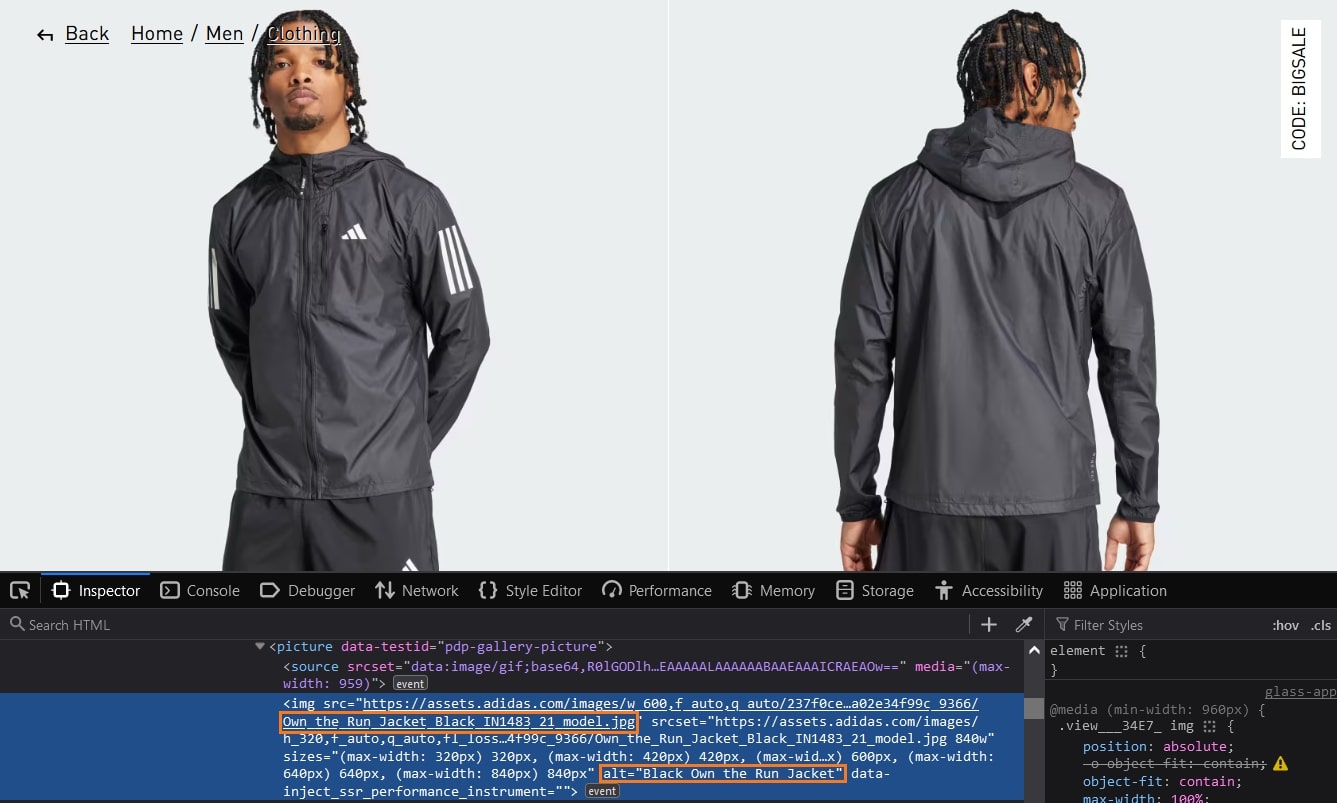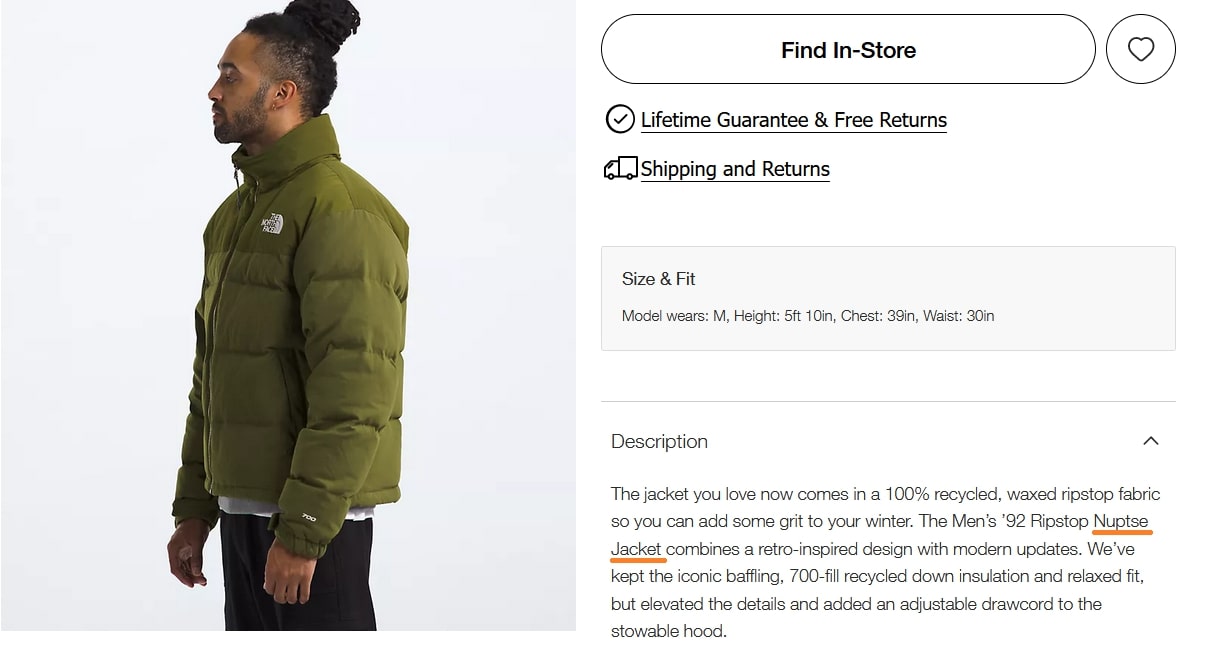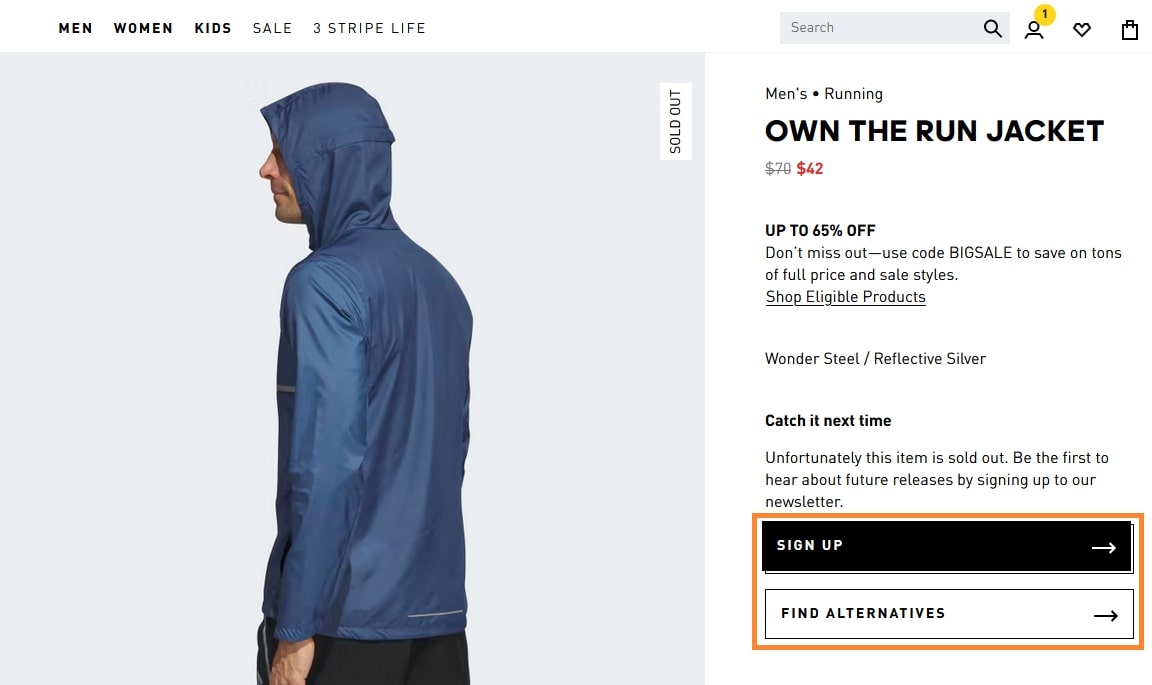Optimizing your product pages can significantly increase your search engine ranking, improve user experience, increase conversion rates, and even set you apart from the competition. However, it can be challenging to know where to start or apply product SEO techniques without proper guidance.
That’s why we prepared the ultimate guide with top product page SEO for eCommerce tips. You’ll learn all about the do’s and don’ts and which pages to focus on most. Continue reading to learn how to boost your SEO strategy and use it to drive more sales.
eCommerce product page SEO tips
Here are our top 13 tips to implement into your product SEO strategy and boost rankings:
1. Align product titles with your keyword research
Start boosting product visibility by identifying the target keywords for your product titles. You want to make sure they resonate with your target audience and the best way to ensure that is to conduct keyword research.
Think about what is relevant to users who are looking for your product. If you have paid search data, you can utilize it for your research, too. Additionally, review your competitors and the keywords they’re focusing on most.
Your target keyword should appear in your product name, meta title, meta description, and the URL. However, the title and the category shouldn’t be identical.
For example, let’s say you’re selling jewelry online. If the product category is “Three stone rings,” your product title shouldn’t be the same. Instead, focus on providing more information about its features, such as brand + category + specifics. In such a case, the title could be “Diamond Frame Three Stone Ring in 14K White Gold.”
It’s also important to note that your product page should include only one first-level heading to ensure a clear page structure for search engines.
2. Optimize product images
Product images and videos are usually the first thing people look at when visiting the product page. If an image isn’t captivating, product sales are likely to be lower too, no matter how good the text is.
Follow these simple steps to optimize product images for SEO:
- Use the proper size. While it depends on your website layout, the usual recommended image size is up to 1500x1000px.
- Choose the correct format. The new popular WebP format allows you to reduce your image size while still keeping the quality high.
- Write an informative alt text. Alt text is visible when your visual doesn’t load, so make sure you write a concise description of the image.
- Consider a descriptive file name. Straightforward file names help search engines understand image content better, increasing your chances of ranking higher in image search results. Make sure you use hyphens in between words to increase clarity.
While image data is important, you shouldn’t overstuff it with keywords. If we take a look at the Adidas product page example, we can see that their alternative text and file name are similar.
Both image data entries are simple yet descriptive. They include the main keyword, making it easier for search engines to figure out what the content is about.
Suggested reading
3. Create descriptive meta titles
Meta title refers to the title of the webpage that visitors see on search engines. It should be easy to read and include target keywords, such as the product name and category. Ideally, it should be between 30 to 60 characters.
For instance, here’s what the Adidas meta title looks like:
As you can see, it has all of the most important information included – brand name, jacket name, color, and category. And it’s just 49 characters long, which fits the length requirements perfectly.
4. Persuade with meta descriptions
Just like meta titles, meta descriptions should be straightforward and include relevant keywords. However, their purpose is to give visitors insights into what the particular page is about in just 70 to 155 characters.
Plus, meta descriptions should persuade users to click. This can be done by mentioning any applicable discounts, free shipping, or other beneficial offers.
Let’s take a look at an example of Patagonia, an outdoor clothing and gear store:
Their meta description includes relevant information about the page content, in this case, women’s outdoor clothing. It mentions product benefits, adds a free shipping notice, and adheres to length guidelines (130 characters).
Tip: you can use our Meta title & description checker to optimize your SEO metadata and boost site rankings.
5. Write unique product descriptions
When users visit product pages with the intent to buy, they’ll usually skim through text. That’s why it’s best to focus on quality instead of quantity. Avoid writing page-long product descriptions and rather focus on delivering useful information.
Here are some tips for writing engaging product descriptions:
- Identify brand voice. Users are looking for something real, so make sure you determine what your brand is about, its target audience, and craft relevant content accordingly.
- Highlight benefits. Stating features of the product isn’t likely to convince customers to buy your product. Instead, focus on the benefits that they bring to your buyers.
- Target product SEO keywords. You should place 1 or 2 relevant keywords into a product description but avoid stuffing. Put more focus on the quality of your text.
- Choose the right description length. Identify if your audience has low or high awareness about your product. Customers with lower awareness will need more convincing than those with high awareness.
With all these points in mind, the most important part about writing a compelling description is knowing your brand voice and target audience.
Let’s take a look at a few examples of different brand like Adidas or Luxury co voices:
First up, Adidas is a well-known brand for its athletic apparel. Appropriately, their product descriptions focus on highlighting the benefits of their product for different sports, like running.
Meanwhile, The North Face creates fashionable outdoor apparel. That’s why their descriptions focus on design, quality, and even durability.
Notice how both product descriptions are short and straightforward. They sprinkle just a few keywords (underlined in orange) but focus on appealing to their audience more.
6. Keep product URLs short and concise
Using a concise URL structure ensures that search engines understand how your website is organized. It helps simplify customer experience and create shareable links that are suitable for marketing initiatives.
For product SEO pages, you should strive to create URL slugs that are short and simple to follow.
As an example, let’s say you run an online bookstore and need a product page URL for the book “Harry Potter and the Philosopher’s Stone.” In this case, your URL could look something like this:
https://bookstorename.com/fiction/children-books/harry-potter-and-the-philosophers-stone/If you sell products that apply to multiple categories, avoid duplicates and make sure you keep only one URL per product.
7. Avoid product page cannibalization
Product cannibalization happens when two or more URLs of the same website are competing for the same or similar keywords. This confuses search engines, reducing chances for cannibalizing pages to rank at the top of results.
With eCommerce product pages, cannibalization often happens if:
- The same product is used in different categories (common in eCommerce platforms like Shopify, where the category name is often used in the URL).
- The same product has multiple variations (such as color) but each variation is not listed as a separate product with a dedicated URL.
In both cases, you can fix cannibalization by adding canonical tags on the main page. All you have to do is put the rel=”canonical” tag in the HTML code <head> section of your primary page version. For example:
<link rel="canonical" href="https://example.com/best-deals/product-name/" />By doing this, you inform search engines which URL should be considered the primary version of your content. This way, your product page has a much higher chance of being indexed and ranking higher.
8. Implement product structured data
Structured data, also known as schema markup, gives search engines specific information about your website. Incorporating it can enrich your search results with organized information, which can lead to much higher user engagement.
To help you visualize, here’s what Patagonia’s rich results look like:
In this case, viewers get instant access to information regarding the price, delivery, money-back guarantee, and availability. This gives potential visitors compelling reasons to check out the link.
To help website owners understand structured data, Google, Bing, Yandex, and Yahoo collaborated to establish the Schema.org vocabulary. It easily translates your site into code that search engines can comprehend. You can learn how to add product structured data by following Google Search Console’s tutorial.
Tip: If you’re using Shopify, you can skip the hassle of figuring out how to implement structured data into your pages with the TinyIMG SEO Optimization app or hiring an expert.
9. Add product reviews option
Integrating reviews into your product page is a powerful strategy to build customer trust and increase conversions. Visitors highly value the opinions and experiences of other shoppers, and reviews only help them understand your products better.
Moreover, reviewers may provide insights that cater to specific audience needs, such as ease of use or durability. This can further build up confidence in your product, encouraging site visitors to make informed purchasing decisions.
In terms of SEO, your ratings can end up appearing in rich results. This makes you stand out from competitors with regular search results.
For example, here’s how the review snippet looks like on Reebok product pages:
Google takes your product rating summary and places it directly in search results, grabbing the attention of potential visitors and making your products or services look more credible.
10. Include an FAQ section
Another convenient way to improve your SEO for products is to add an FAQ section. Knowing the right questions and providing straightforward answers can get you higher in search results and pull more visitors.
On the other hand, if you’re not sure of what questions to include, you can create a Q&A section that is moderated. This will help visitors ask relevant questions without having to search for your support page or seek answers elsewhere.
If you decide to implement these sections into your page, you have to add structured data accordingly – either FAQPage type or QAPage type. By doing this, you may even get a markup on search results, which can end up driving even more organic traffic.
11. Ensure fast product page load
Improving your eCommerce website speed can significantly increase your sales. In 2022, a study by Portent showed that websites that load in 1 second have a 3 times higher conversion rate than sites that load in 5 seconds.
So, if your product pages take longer than 3 seconds to fully load, you can take a few steps to boost its performance:
- Optimize images. Make sure you compress your product page images and change their format. You can convert images into WebP to reduce them while maintaining high quality.
- Use a Content Delivery Network (CDN). If you want to distribute your website across multiple international servers, using a CDN can help reduce latency or request times, thus improving your site’s loading speed.
- Minify CSS and JavaScript. Minifying CSS or JavaScript code means removing unnecessary characters that weigh down your load time without changing its functionality.
- Remove unused applications. Unnecessary plugins and applications can drastically slow down your site. Assess which plugins have redundant functionality, you no longer use, or require updates.
- Implement lazy loading for heavy assets. Lazy loading is used to decrease the number of requests made to your server. It simply loads heavy assets only when a user scrolls by them.
You can check if your web page load time needs optimization on such sites as Google PageSpeed Insights.
12. Improve product page UX
Product page user experience (UX) plays an important role in SEO. A page that isn’t optimized for user convenience will likely end up having a high bounce rate. In turn, this can signal to search engines that your website shouldn’t rank high.
There are various ways you can improve product page UX. For starters, product pages are the last place consumers want to find clutter. Instead of providing page-long text, make sure you use drop-down boxes, hover-over content, and similar elements to make the page more structured.
Additionally, pay attention to customer habits. From simple color choices to button placement, anything can influence visitor decisions – that’s just psychology. If you’re uncertain about customer behavior, you might want to explore tools like Hotjar heatmaps or live session recordings. They can give you insight into how consumers engage with specific pages.
Lastly, if you’re not sure if you’re moving in the right direction – ask your friend to test your site out. This will help you look at your pages from a visitor’s perspective. Take notes on anything they suggest improving, changing, or getting rid of.
13. Check for technical product page issues
Technical product page issues can not only affect user experience but also SEO. To put it short, they can waste your crawl budget or split link equity.
For example, duplicate content can exhaust search engine crawler’s resources, failing to enhance site visibility in search results. Meanwhile, broken links can result in wasting link equity, which contributes to determining website authority and ranking in search engines.
Here are some of the most common technical site issues and how to fix them:
- Duplicate pages. Audit your pages to find duplicate ones and replace them with unique ones.
- No-index tags. No-index tags are useful when you don’t want a page to appear in search engines. However, if you want the page to be indexed, simply remove the tag.
- Too much JavaScript usage. Make sure the most important content, such as headings, product information, and above the fold images, are visible without JavaScript. Search engine crawlers may not index pages that are only accessible through this language, which can affect your site’s visibility in search results.
- Broken links. Google Search Console offers a functionality called Crawl Errors, which generates reports that display all pages that return the 404 error on your website.
- Missing/incorrect structured data. Make sure your site’s structured data is in place and correct. If you’re a Shopify user, you can use our TinyIMG SEO Optimization app or hire an expert to add the needed structured data for you.
- Redirects. Avoid including internal links on your site that point to redirected pages, as it can harm your SEO efforts and confuse search engine crawlers, resulting in slower page indexing.
Product page optimization mistakes
If you’re struggling to get your product pages to rank on search engines, make sure you avoid these common mistakes:
1. Using manufacturer's product descriptions
Using default product descriptions provided by the manufacturer is a fast track to wasted SEO efforts.
For starters, manufacturer descriptions usually don’t include engaging keywords that are crucial for ranking in search engines. Plus, they’re written in a basic or technical way, disregarding product benefit mentions. Lastly, they’re boring.
While descriptions may seem like a small part when optimizing SEO products, they can highly affect your sales. Crafting captivating descriptions that highlight product benefits, features, and other aspects will not only help earn search engine favor but also improve customer experience.
2. Not using internal linking
Internal linking is invaluable for boosting product page visibility on search engines. Such practice helps spread link equity, giving more authority and ranking power to linked pages. This way, search engines can find your product page faster and rank it higher.
Moreover, increasing product page ranking is more likely to attract customers, thereby boosting conversion rates. So, prioritize placing internal links to your most popular products to maximize their performance.
Here are a few ways you can implement internal linking to your product pages:
- Featured product section. You can showcase your products straight on your site’s homepage, linking to their respective pages.
- Related product section. You can link to your products in the related products section of other pages. This allows visitors to explore alternative offerings in case the current selection doesn’t fit their needs or is out of stock.
- Blog articles. If your website runs a blog, you can mention your products in related articles and place a hyperlink to direct readers to the product page.
- Mega menu. You can use the mega menu (large popup window that displays site categories) to include links to the most popular product pages, providing users quick access to your most desired items.
3. Not optimizing product pages for mobile
SEO product page optimization on mobile devices can not only improve search engine ranks but also conversion rates.
According to the Dynamic Yield study, 76% of consumers shop on smartphones to save time, yet only 12% find it convenient. If your website looks the same on mobile as it does on laptops, potential customers are more likely to switch to competitors.
The same study found that 67% of smartphone users agree that the main barrier to mobile shopping is the inconvenient size of pages and links.
Here are a few tips to consider when optimizing your site for mobile devices:
- Use a responsive template or design to create an easy-to-navigate structure.
- Make sure the text is short and simple to allow easy text scanning.
- Include mobile payment options, such as Google Pay or Apple Pay to increase a sense of safety for users.
- Reduce graphics and popups to save screen space.
- Make buttons on the page large.
- Test any changes and how users respond to them.
4. Creating generic metadata for all product pages
Steer clear of creating generic metadata for all product pages. It won’t convince users to click on your site and it definitely won’t appeal to search engines.
In terms of meta titles, don’t just mention your product and brand name. Keep it short but be descriptive. For example, try to include the target keyword and a unique selling point that appeals to your product.
As for meta descriptions, be persuasive. This is your chance to convince users who encounter your page on search engines to click your link. You have up to 155 characters to explain the main benefits of your product and include a call to action.
5. Relying solely on automated optimization
In a world where search engines are getting smarter every day, automated optimization alone just won’t work. Search engines are prioritizing real human engagement, so they’ll only rank content that is authentic and unique.
Plus, if you solely rely on automated optimization, you might overlook important SEO factors. However, if you combine it with manual efforts, you may discover the best SEO solutions tailored to specific product page needs.
6. Deleting out-of-stock product pages
If you delete out-of-stock product pages, especially the ones that rank on search engines, you will lose many traffic and sales opportunities.
Just because a product is out of stock, it doesn’t mean the page isn’t valuable. You can leverage the page by offering links to alternative products the user might be interested in.
Let’s take Adidas Own the Run Jacket as an example. In search results, this product ranks high, even if the review snippet shows that it’s out of stock.
Once users access the page, they’re given two options. First off, they can ‘sign up’ to the newsletter that will alert them when the product is back in stock. Second, they can click ‘Find alternatives’ which is a jump link to the ‘Others also bought’ section.
This way, Adidas strategically uses a high-ranking page to leverage incoming traffic and direct potential customers to similar products they might enjoy and end up purchasing.
7. Neglecting backlink opportunities
Most companies try to get backlinks on home and category pages, but it’s important to not overlook the value of using them for eCommerce SEO product pages.
Product pages have a high chance of ranking, and backlinking only ensures the authority and relevance of such pages. This can increase your search engine visibility, eventually driving more sales.
Do I need to optimize each product page?
The eCommerce landscape is competitive, which is why the more product pages you optimize the better. While it can be a tedious task, you don’t have to do it all at once.
Start by analyzing your product pages and find which ones generate the most revenue or traffic. Once you optimize the most important pages and make them unique, you can move from there.
If your product page visitors receive all the valuable information they were looking for and more, they’re much more likely to make a purchase.
Here are the main benefits of optimizing product pages:
- Improves page authority and ranks higher on search engines.
- Enhances user experience, making content more compelling and relevant.
- Maximizes your online presence and helps you stand out from the competition.
- Drives more sales.
To optimize your product pages successfully, focus on improving the most impactful parts. This includes anything from crafting engaging product descriptions and metadata that demonstrate your product benefits to conducting keyword research and creating useful review snippets.
Final thoughts
Product SEO plays a crucial role in positioning your product pages to compete with market rivals and improve your brand image.
By implementing SEO techniques like crafting compelling metadata, writing user-oriented product descriptions, and ensuring the best user experience, you’re much more likely to encourage customers to return to your website.
These practices will not only improve your brand strategy but yield noticeable results, from higher search results to increased conversion rates.
Curious to read more? Check out these articles:


Frequently asked questions
To improve product page SEO rankings, you should optimize the content. This includes crafting engaging metadata and product descriptions, optimizing product images, increasing page loading speed, and improving user experience across all devices.
You can improve product page visibility in search engines by implementing optimized images and adding product structured data. This can help you get rich snippets, which provide detailed product information directly in search results, making it stand out from the competition.
The first step to getting more backlinks to your product pages is to create high-quality products and engaging content that is relevant to them. Then, look for resource pages to be featured on, use HARO to find press connections, promote content to sites that already link to your competitors, or target list articles like “Best [products] in [year].”











